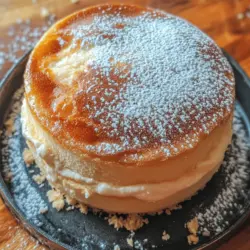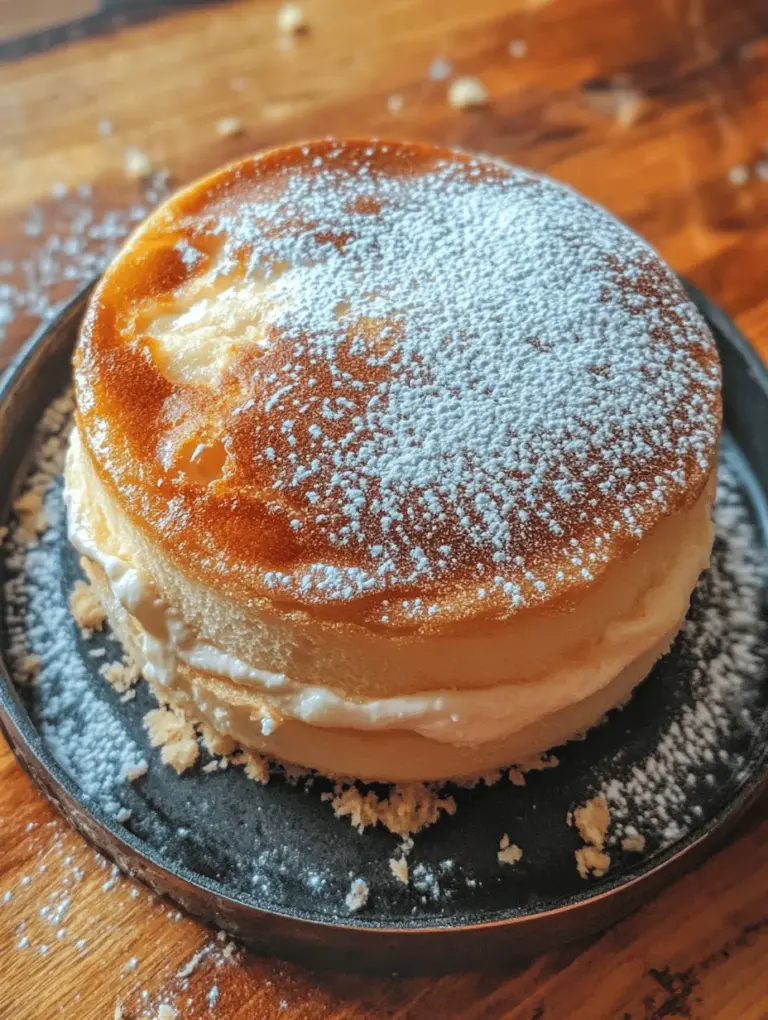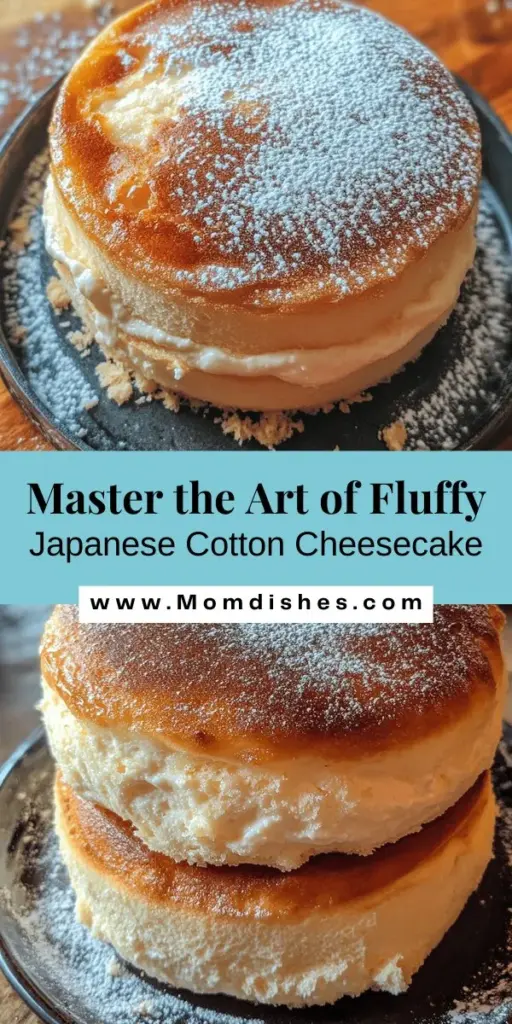Introduction
In the world of desserts, few creations have captured the hearts of bakers and dessert lovers alike quite like the Japanese cotton cheesecake. Renowned for its ethereal texture and light, airy flavor, this delightful treat has gained immense popularity beyond Japan, enticing both novice and experienced bakers to try their hand at making it from scratch. What sets this cheesecake apart from traditional varieties is not only its unique soufflé-like quality but also its melt-in-your-mouth experience that leaves a lasting impression.
This article aims to be your comprehensive guide to mastering the art of Japanese cotton cheesecake, offering detailed insights and step-by-step instructions on how to create this fluffy wonder in your own kitchen. By the end, you’ll not only understand the origins and significance of this dessert but also have the knowledge to impress your friends and family with a perfectly baked rendition.
Understanding Japanese Cotton Cheesecake
To truly appreciate the allure of Japanese cotton cheesecake, it’s essential to delve into its origins and the cultural significance it holds in Japan. The dessert first emerged in the 1980s and quickly became a beloved staple in Japanese bakeries. Often referred to as “soufflé cheesecake,” its name reflects the lightness and airy texture that it embodies. Unlike traditional cheesecakes that can be dense and heavy, the Japanese cotton cheesecake is renowned for its delicate balance of creaminess and fluffiness.
The texture is achieved through a unique baking method that incorporates whipped egg whites into the batter, creating a soufflé-like lift during baking. This innovative technique results in a cheesecake that is not only visually appealing but also creates a delightful experience with each bite. The cake is slightly jiggly in appearance, resembling a cloud, which is where the “cotton” in its name comes from.
In terms of taste, Japanese cotton cheesecake offers a subtle sweetness paired with the rich, creamy flavor of cream cheese. The addition of lemon juice and vanilla extract enhances the overall flavor profile, making it a delightful dessert that can be enjoyed on its own or paired with fresh fruits or sauces.
The science behind its fluffiness lies in the incorporation of air into the batter. By carefully separating eggs and whisking the egg whites to stiff peaks, bakers create a light and airy structure that supports the cake as it bakes. This method not only sets the Japanese cotton cheesecake apart from its denser counterparts but also introduces an element of precision and attention to detail, essential for achieving that perfect fluffy finish.
Ingredients Breakdown
Before diving into the steps of making Japanese cotton cheesecake, it’s crucial to understand the role of each ingredient in creating this light and creamy dessert. Here is a breakdown of the key components used in the recipe:
1. Cream Cheese: The star of the cheesecake, cream cheese brings a rich and creamy texture that forms the base of the cake. It’s essential to use high-quality cream cheese, as it significantly impacts the flavor and texture of the final product.
2. Butter: Unsalted butter adds richness to the batter and helps achieve a smooth consistency when combined with cream cheese. The fat content from the butter also contributes to the cake’s moistness.
3. Milk: Milk is another key player in achieving that creamy texture. It helps to thin out the batter, making it easier to blend the ingredients and ensuring a smooth final product.
4. Eggs: Eggs are vital to this recipe, both for structure and lift. The separation of yolks from whites is a critical step; the yolks contribute richness, while the whipped egg whites provide the essential fluffiness.
5. Lemon Juice: A touch of lemon juice not only enhances the flavor but also helps stabilize the egg whites during whipping. This acidity contributes to a well-rounded flavor and can balance the sweetness of the cake.
6. Vanilla Extract: Adding vanilla extract enhances the overall flavor profile of the cheesecake. It provides a warm, aromatic quality that complements the richness of the cream cheese.
7. Flour and Cornstarch: These dry ingredients are crucial for the structure of the cake. They help to bind the wet ingredients together while maintaining a light texture. The combination of flour and cornstarch allows for a delicate crumb.
8. Powdered Sugar (optional): While not mandatory, powdered sugar can be used for dusting the top of the cheesecake once it’s baked and cooled. This adds a touch of sweetness and elevates the presentation, making it even more appealing.
Understanding the roles of these ingredients will help you appreciate the delicate balance required to create a successful Japanese cotton cheesecake. Each component plays a vital role in achieving the desired texture and flavor, so it’s essential to use them thoughtfully.
Step-by-Step Instructions
Now that you have a grasp of the ingredients and their functions, it’s time to embark on your journey to creating the perfect fluffy Japanese cotton cheesecake. Follow these detailed steps to ensure your success:
1. Preheating the Oven
The first step in making your Japanese cotton cheesecake is to preheat your oven to 320°F (160°C). This temperature is crucial, as it allows for even baking and helps the cake rise without browning too quickly. While the oven preheats, you can prepare the other components of the recipe.
2. Preparing the Cake Pan
Proper preparation of your cake pan is essential for ensuring that your cheesecake comes out cleanly after baking. Begin by greasing the bottom and sides of an 8-inch round cake pan with butter. Next, line the bottom with parchment paper to prevent sticking. For added assurance, you can also line the sides of the pan with parchment paper. This will help create a smooth surface and make it easier to remove the cheesecake once it has cooled.
3. Melting the Ingredients
To create a smooth and creamy batter, it’s important to melt the cream cheese and butter together. The best method for this is using a double boiler. Fill a saucepan with a small amount of water and bring it to a simmer. Place a heatproof bowl over the saucepan, ensuring it doesn’t touch the water, and add the cream cheese and butter to the bowl. Stir gently until both are melted and combined, creating a smooth mixture. This gentle heat prevents the ingredients from scorching and maintains their creamy texture.
4. Whisking Egg Yolks
Once the cream cheese and butter mixture has cooled slightly, it’s time to whisk in the egg yolks. In a separate bowl, beat the egg yolks until they are pale and frothy. Gradually add the melted cream cheese-butter mixture to the egg yolks, whisking continuously until fully combined. This step is crucial, as it helps to create a stable batter. You want to achieve a smooth consistency without any lumps, which is key to the final texture of your cheesecake.
5. Preparing for the Egg Whites
After you’ve successfully combined the egg yolks with the cream cheese mixture, it’s time to focus on the egg whites. In a clean, dry mixing bowl, begin beating the egg whites using an electric mixer on medium speed. As they start to foam, add a pinch of salt and a few drops of lemon juice. This will help stabilize the egg whites, allowing them to reach stiff peaks more easily.
By carefully following these initial steps, you’ll set a strong foundation for creating a beautiful and delicious Japanese cotton cheesecake. Stay tuned for the next part, where we will continue with the remaining instructions to complete this delightful dessert!
{{image_1}}
Combining Mixtures
When it comes to achieving that signature fluffy texture of Japanese cotton cheesecake, the way you combine your mixtures is essential. Gradual mixing is crucial; this process allows you to incorporate air into the batter without deflating it. Begin by adding your egg yolk mixture to the cream cheese mixture slowly. Use a spatula or a whisk to gently fold the ingredients together. This ensures that the air bubbles created during the whipping process remain intact, contributing to the light and airy structure of the cheesecake.
Sifting Dry Ingredients
Sifting your dry ingredients is a step that should never be overlooked. While it may seem trivial, sifting plays a vital role in the baking process. It helps to break up any lumps in the flour, sugar, and cornstarch, ensuring a smooth batter. This step is especially important in delicate recipes like this cheesecake. To sift, simply place your dry ingredients in a fine-mesh sieve and shake it over your mixing bowl. This will aerate the flour and evenly distribute any leavening agents, promoting a uniform rise during baking.
Beating Egg Whites
Achieving the perfect texture in your Japanese cotton cheesecake heavily relies on how you beat your egg whites. Start with clean, dry mixing bowls and beaters, as any residual fat can prevent the egg whites from reaching their maximum volume. Begin by whisking the egg whites on medium speed until they become frothy. Gradually add in sugar, continuing to whisk until soft peaks form. Soft peaks are characterized by a gentle curl at the tips when the beaters are lifted. For stiff peaks, increase your mixer speed and continue beating until the egg whites are glossy and hold their shape firmly. This step is crucial, as stiff peaks provide the necessary structure for your cheesecake.
Folding Techniques
Once your egg whites are whipped to perfection, the next challenge is to incorporate them into the batter without losing all that precious air. This is where folding techniques come into play. Using a rubber spatula, add a small portion of the whipped egg whites to your cream cheese mixture. With a gentle motion, fold the mixture over itself, rotating the bowl as you go. It’s important to cut down through the center of the mixture and then lift and turn it over. Repeat this process, gradually adding more egg whites until fully incorporated. Avoid vigorous stirring, as this can deflate the batter and compromise the fluffiness of your cheesecake.
Baking in a Water Bath
Baking your Japanese cotton cheesecake in a water bath is a method that significantly affects the final texture. The water bath provides a gentle and even heat, preventing the cheesecake from rising too quickly and cracking. To prepare, wrap the outside of your springform pan with aluminum foil to prevent water from seeping in. Place the pan in a larger baking dish and fill it with hot water until it reaches about halfway up the sides of the springform pan. This technique also helps to create a moist baking environment, which is key in achieving that soft, cotton-like texture.
Cooling and Chilling
Once your cheesecake has finished baking, the cooling process is just as important as the baking itself. Allow the cheesecake to cool in the water bath for about an hour before transferring it to a wire rack. This gradual cooling helps prevent cracks from forming on the surface. After it has cooled to room temperature, refrigerate the cheesecake for at least four hours, preferably overnight. This chilling time allows the flavors to meld and the texture to set properly, resulting in a creamy, melt-in-your-mouth dessert.
Tips for Success
To master the art of Japanese cotton cheesecake, consider these practical tips:
1. Avoid Overmixing: One of the most common pitfalls is overmixing the batter after adding the egg whites. This can lead to a dense cheesecake instead of a light one. Always fold gently and only until no white streaks remain.
2. Check for Doneness: Underbaking can lead to a gooey texture, while overbaking can dry it out. A good indicator of doneness is a slight jiggle in the center when the cheesecake is gently shaken.
3. Achieving a Golden Top: For that beautiful golden top, ensure that your oven is preheated, and consider using the broil setting for the last few minutes of baking. Keep a close eye to prevent burning.
4. Chilling Time is Key: Don’t rush the chilling process. The flavor and texture improve significantly after a proper chill. This step allows the cheesecake to firm up and makes slicing easier.
Serving Suggestions
Japanese cotton cheesecake is versatile and can be served in various delightful ways. Here are some ideas to enhance your dessert experience:
– Pairing Ideas: This cheesecake pairs beautifully with beverages like green tea or a light coffee. The subtle flavors of these drinks complement the delicate nature of the cheesecake.
– Presentation Tips: For an elegant dessert display, serve slices on a decorative plate with a dusting of powdered sugar or a drizzle of fruit coulis. Fresh berries or a sprig of mint can add a pop of color and freshness.
– Alternative Toppings: Experiment with different toppings to create unique flavor profiles. Consider adding a layer of lemon curd for a citrusy twist, or serve with a dollop of whipped cream and a sprinkle of matcha powder for an earthy flavor.
Conclusion
Baking a Japanese cotton cheesecake is not only a rewarding culinary challenge but also an opportunity to experience the joy of creating a dessert that is light, fluffy, and utterly delicious. By mastering the techniques discussed, you’ll be able to produce a cheesecake that is not only visually stunning but also a delight to the palate. The cultural richness of this dish, originating from Japan, reflects the care and precision involved in its preparation.
Encourage your friends and family to join you in this delightful baking adventure. With practice, this Japanese cotton cheesecake can become a beloved family favorite, bringing smiles and satisfaction with every slice. So don your apron, gather your ingredients, and embark on this exciting journey into the world of Japanese baking. Happy baking!


